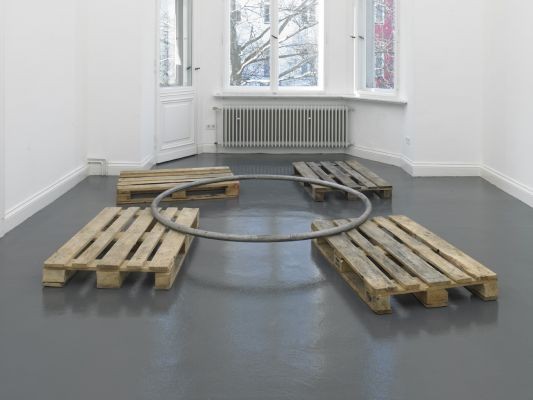Jürgen Drescher
26 Feb - 16 Apr 2011
JÜRGEN DRESCHER
26 February — 16 April, 2011
Klosterfelde is pleased to announce their first exhibition with Jürgen Drescher. From the early 1980s, after being a student of Klaus Rinke at the post-Beuysian Düsseldorf Academy, Drescher has concerned himself with wide-ranging formal, political and poetic aspects of sculpting, while his all-pervasive interest in language also brought forth performative installations, text images and video.
Since his first known works, such as DRESCHER Bar (1981) or Zu groß für über’s Sofa (1984), Drescher examines complicated sculptural interrelations between model and reality, abstraction and metaphor, original and replica. The main strategy is always one of transfers – everyday objects are put in new (exhibition-) contexts or substantially transformed by means of reproduction technologies like casting in metal. While the legacy of Minimal Art of the 60’s and 70’s has reduced the material language to very basic elements, the appropriation of everyday objects like removal boxes, pallets, ladders and entire fair booths refers to social reality and the artist's own existence. Reflections on his own artistic activity and the economic framework of the market remain an important part in the work of Jürgen Drescher.
The new works investigate inherent artistic problems of the relationship between sculptural form, language, and reality. The self-referential title of the exhibition Jürgen Drescher already points very clearly to the notion of the artist’s own existence. The twofold name reflects the limbo between fiction and reality, between omnipotence and scepticism, and evokes the various other reproduction techniques used like aluminium casts. For Der Boden unter Benns Boden (2008/2010) Drescher has rescued the Linoleum flooring from a Kreuzberg pharmacy underneath Gottfried Benn’s apartment from clearance, only to have it laid out again in one of the gallery rooms. With this new context, the sculpture raises questions about temporal relations and the history of spaces, about originality and the authenticity of artistic biographies. This happens in stages of abstraction – it is not the real Benn floor but the one from ‘one floor down’, which relates to the original like the negative to the cast.
The complex relation of the used materials to reality is also visible in Kreuz Sprechblase Handschuhe (2010): here, wooden slats cast in aluminium were bolted to a minimal framework of crosses open at one side, used gloves put over the left and right ends of the structure, a black speech bubble made of cloth mounted as ‘head’, serving as a rhetorical cartoon token that marks the blank space of the thought. In Ring auf Paletten (2010) a cast aluminium ring lies on four wooden pallets: objet trouvé, abstract geometrical form, reflection on space and emptiness? At the same time, the pallets and the ring also bring into play notions of mobility and of circulation of goods. The works of Jürgen Drescher call for a reversal of sculptural, spatial, and not least of social thinking.
26 February — 16 April, 2011
Klosterfelde is pleased to announce their first exhibition with Jürgen Drescher. From the early 1980s, after being a student of Klaus Rinke at the post-Beuysian Düsseldorf Academy, Drescher has concerned himself with wide-ranging formal, political and poetic aspects of sculpting, while his all-pervasive interest in language also brought forth performative installations, text images and video.
Since his first known works, such as DRESCHER Bar (1981) or Zu groß für über’s Sofa (1984), Drescher examines complicated sculptural interrelations between model and reality, abstraction and metaphor, original and replica. The main strategy is always one of transfers – everyday objects are put in new (exhibition-) contexts or substantially transformed by means of reproduction technologies like casting in metal. While the legacy of Minimal Art of the 60’s and 70’s has reduced the material language to very basic elements, the appropriation of everyday objects like removal boxes, pallets, ladders and entire fair booths refers to social reality and the artist's own existence. Reflections on his own artistic activity and the economic framework of the market remain an important part in the work of Jürgen Drescher.
The new works investigate inherent artistic problems of the relationship between sculptural form, language, and reality. The self-referential title of the exhibition Jürgen Drescher already points very clearly to the notion of the artist’s own existence. The twofold name reflects the limbo between fiction and reality, between omnipotence and scepticism, and evokes the various other reproduction techniques used like aluminium casts. For Der Boden unter Benns Boden (2008/2010) Drescher has rescued the Linoleum flooring from a Kreuzberg pharmacy underneath Gottfried Benn’s apartment from clearance, only to have it laid out again in one of the gallery rooms. With this new context, the sculpture raises questions about temporal relations and the history of spaces, about originality and the authenticity of artistic biographies. This happens in stages of abstraction – it is not the real Benn floor but the one from ‘one floor down’, which relates to the original like the negative to the cast.
The complex relation of the used materials to reality is also visible in Kreuz Sprechblase Handschuhe (2010): here, wooden slats cast in aluminium were bolted to a minimal framework of crosses open at one side, used gloves put over the left and right ends of the structure, a black speech bubble made of cloth mounted as ‘head’, serving as a rhetorical cartoon token that marks the blank space of the thought. In Ring auf Paletten (2010) a cast aluminium ring lies on four wooden pallets: objet trouvé, abstract geometrical form, reflection on space and emptiness? At the same time, the pallets and the ring also bring into play notions of mobility and of circulation of goods. The works of Jürgen Drescher call for a reversal of sculptural, spatial, and not least of social thinking.

